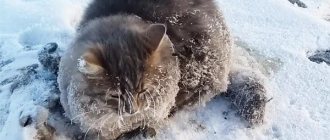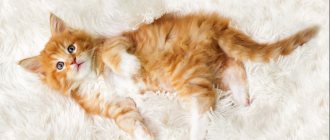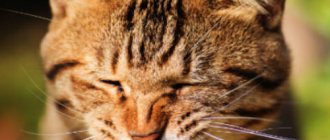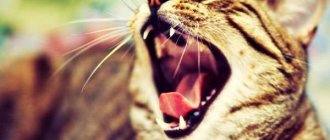When cats can shake
Cats can tremble not only in their sleep, but also while awake. The main problem for the owner is determining the cause of the trembling and whether any disease is present.
If this phenomenon occurs quite often, it is necessary to determine the room temperature. If the room temperature is not comfortable for the pet, measures should be taken to provide warmth to the pet. The measure consists of raising the room temperature or providing the animal with warm bedding and eliminating drafts.
It is necessary to provide cats with warm bedding.
Sign that the cat is freezing
A sign that your pet is freezing can be the “curl” position adopted during sleep and a deeply hidden nose.
The cat hides its nose if it is cold.
Sleep tremor
Why do cats tremble in their sleep? Cats, like people, dream. When entering a deep phase of sleep, the animal may twitch its paws, its eyelids may tremble, its skin may twitch, and sometimes trembling may occur throughout its body.
It even happens that the fur on the back of the neck fluffs up, and the animal makes sounds when the dream is very vivid. Such manifestations are completely normal. A quarter of the total sleep duration is occupied by the deep phase. This is usually when a cat curls up into a ball before going to sleep. In this position, she is able to relax her muscles as much as possible.
By the way, sometimes animals can tremble because they are seeing some kind of nightmare. But when the cat wakes up, everything will pass.
By the way, sometimes animals can tremble because they are seeing some kind of nightmare. But when the cat wakes up, everything will pass.
Associated symptoms
The red cat is trembling, why?
Let's take a closer look.
Subclinical form of panleukopenia
In the subclinical form of panleukopenia, the cat develops lethargy and fever.
Hidden period of rhinotracheitis
Apathy and loss of appetite appear in a cat with rhinotracheitis.
The latent period of rhinotracheitis lasts about a week.
Calcivirus infection
Calcivirus infection can be expressed by discharge from the eyes.
Puberty of a cat
One of the main reasons is puberty in the cat or the period of estrus.
One of the reasons for trembling is puberty in a cat.
If this is a young animal, such a condition causes unreasonable fear and, as a result, stress.
Central nervous system disorders
If during the daytime a pet tries to hide in a dark corner, this may indicate a disorder of the central nervous system and diseases such as meningitis, myelitis or neuroses of any nature.
With meningitis, depression will be present.
Diseases that cause tremors of the head, limbs and whole body
If a cat's head, paws, or entire body is trembling, this is probably due to internal problems. This may be a lack of vitamins and minerals in the body, viral infections, helminthic infestation, or neurological disorders. Typically, diseases that cause tremor are accompanied by other symptoms. Only a veterinarian can identify the problem and cure the animal.
In this situation, together with your veterinarian, it is recommended to review your pet’s diet. If necessary, the veterinarian will advise you to include in the cat’s menu foods rich in substances necessary for the four-legged patient, if the cat eats natural food, or to replace unsuitable ready-made food with another product. Your cat may also need to take vitamin and mineral supplements.
Viral infections
The cause of tremor in a kitten and a mature animal can be an infection of viral etiology, in particular calicivirus and rhinotracheitis. The causative agents of the first disease are microscopic RNA-containing non-enveloped viruses of the calicivirus genus of the caliciviridae family, the second - certain viruses of the herpes group, as well as caliciviruses and reoviruses. Information about these diseases is presented in the table:
| Type of viral infection | Symptoms | Treatment |
| Calicivirus | Increased temperature, loss of interest in food, weight loss, breathing problems, pale mucous membranes | Maxidin and Fosprenil together with symptomatic therapy, antibiotic therapy (in case of bacterial infection) and Gamavit. Vitafel is effective at the early stage of the disease. The use of Aminovit and Cerebrolysin gives good results. |
| Rhinotracheitis | Lethargy, loss of appetite, cough, photophobia, purulent discharge from the nasal passages and eyes, excessive salivation, fever, inflammation of the tongue, ulcerative stomatitis | Maxidin together with Fosprenil and Gamavit or Vitafel. Often, four-legged patients are injected with specific serums. Antibacterial drugs Ampicillin and Tetracycline are also used when bacterial infection occurs. |
Parasitic infestations
In addition to trembling, helminthic infestation is accompanied by the following symptoms:
- increased appetite;
- perversion of eating behavior - a kitten or adult animal infected with parasites can chew paper and other inedible objects;
- weight loss;
- nausea and vomiting;
- diarrhea or constipation;
- depressed state;
- increased salivation;
- deterioration of the coat condition.
If live helminths are visible in the vomit or feces, it means that the disease has reached a severe stage. If your pet shakes its head as if something is in its ears, you need to inspect the ear canals for mites. If parasites are detected in a four-legged pet, it should be given an antiparasitic drug. This can only be done after an accurate diagnosis has been made.
Do cats dream?
It was cats, or rather, their dreams, that made it possible to prove to the whole world that animals also plunge into the world of dreams. Moreover, scientists suggest that our pets' dreams are much richer and more dynamic than ours. It all started when doctors began to study the phases of human sleep. To confirm their assumption that healthy people lose the ability to move during REM sleep, an experiment was conducted on a group of cats.
All animals had a small area of the brain removed, which was responsible for muscle atonia in the REM phase of sleep. After the animals were fully rehabilitated, the scientists' suspicions were corrected. The observed cats stood on their paws, walked confidently, and turned their heads, as if watching someone. While in a state of sleep, cats sniffed and turned their ears. The experiment proved that cats see, hear and touch dreams.
This is interesting! A healthy, adult animal does not move during REM sleep, although rapid eye movements and slight twitching are considered normal.
With the development of medical equipment, it was possible to prove that during dreams, cats experience real emotions: fear, joy, excitement, aggression. Near the animals under observation, “pheromones” of a same-sex cat were sprayed and the observed one showed aggression. In the opposite case, when the scent of an animal of the opposite sex was sprayed, the observed behaved calmly or interestedly. That is, animals not paralyzed by the REM phase not only sensed the outside world, but also made natural, instinctive decisions. These observations led to the conclusion that in their dreams, cats see themselves and their surroundings very realistically.
This is interesting! Experiments were carried out on cats, dogs and rodents. Cats surprised scientists by very naturally emitting hunting in their dreams. The dogs unexpectedly hinted at the animal essence, imitating the behavior of wild wolves. The rodents broke all records, because even in their sleep they were able to solve the tasks assigned to them.
The study of human and animal sleep continues. Of course, today it is no longer practiced to remove part of the brain for the sake of observation. To relieve atonia during the REM phase, blockades of part of the brain are used. Modern scientists are on the verge of a big discovery, since the experiments included observations of brain activity using highly sensitive scanners. There is no doubt that cats dream, but perhaps we will soon find out exactly what their dream world looks like. Already today, scientists have managed to find out that kittens see their first dreams while still in the womb.
Why does a cat shake with small tremors: reasons, what to do, when to contact a veterinarian
Owners of cats may encounter an unusual condition of the animal: the cat is trembling as if it is cold. The owners see the reason that the pet is simply cold.
But the frequent repetition of this phenomenon serves as a signal that pathological processes are developing in the animal’s body, the animal is experiencing severe stress, and has become infected with an infectious disease.
Unreasonable trembling should be a reason to contact a veterinary clinic to a specialist, where the doctor will identify the presence of disorders and prescribe treatment.
A kitten's active sleep is not a reason to worry
Most of the speculation surrounding the concern comes from kitten owners. We dare to assure you that if your cat twitches in his sleep, but he is not yet 12-15 months old, this is normal . Don't worry if the kitten sleeps in an unnatural position or if its eyes are slightly open. The first is explained by the fact that kittens are not so demanding of comfort, the second is due to the presence of a third eyelid, a transparent film that protects the eye during sleep, even if it is open.
The kitten may twitch violently, roll over, and even meow after stress or active play. If the baby is sleeping and you notice that his paws are twitching, it means that the four-legged animal is walking or running in its sleep. Until 1.5–2 years of age, activity in the REM phase is absolutely normal and is explained by an incompletely formed nervous system.
The REM phase of sleep in kittens up to 6 months takes up about 80% of all sleep time. If you notice that your cat doesn’t startle in its sleep as often as before, you can draw conclusions about the strengthening of the nervous system and the maturation of the animal as a whole. The period of formation of the nervous system is very individual and depends on many factors. In outbred so-called native cats, it lasts up to 10 months; some purebred cats “remain children” for up to two years.
The cat is trembling in a relaxed state, not sleeping.
Dmitry, Belgorod
December 2, 2018
Male, breed: Siberian, 12 years old, weight 6 kg, neutered. We noticed that the cat was vomiting once a month (there wasn’t a lot of vomit, a mush of food, no hair and a little water), no other ailments were observed, the cat was playful, affectionate, loving, appetite, stool was normal, vomited and went about his business as if nothing had happened. But when this happened again for the fourth time, we took him to the local emergency room (as it turned out later, with a bad reputation, they are trying to do maximum manipulations for a good check), I told the doctor everything, said that we wanted to donate blood for biochemistry and a general analysis, and so do an ultrasound or x-ray. As a result, they intimidated me that I didn’t understand anything, that the cat was dehydrated and in pain, they washed me for 2.5 hours, did an x-ray, some subcutaneous injections, took blood, stuffed Omez and some other pills, tried to put a catheter in one paw , it didn’t work out, they shaved the other paw, put it in it (all this time the cat was actively resisting, screaming, trying to escape and was hysterical), they took him to an IV (Trisol), in general, after all this hell, our cat began to tremble, we turned to others The doctors prescribed us various sedatives: 1. Fospasim; 2.Fitex; 3. Corvalol + Popazol + Piracitam; 4.Novopasit in syrup; 5. Gabapentin, but the cat’s trembling does not go away, and after each stressful moment (blood drawing, for example, or a haircut) it intensifies. I’ll describe the trembling: it’s very similar to chills, but he’s definitely not cold, it’s either small or medium trembling, I don’t understand what it depends on. With minor tremors, the front and hind legs and slightly the back tremble. With moderate tremors, the spasm seems to seize the paws, the entire body and head. It trembles ONLY in a relaxed state, when you are busy with something or sleep, there are no tremors. In the morning and during the day there may be no trembling at all or small trembling, in the evening there is always trembling, just sometimes small, sometimes medium, if you start playing with him at moments of trembling, he switches, plays and does not tremble, if you pick him up and walk around the apartment, he doesn’t either trembles if he just sits in his arms or lies - trembles, does not react painfully or aggressively at these moments, responds to a nickname, if you scratch behind the ear he likes it, sometimes he even purrs mixed with trembling. This trembling has been with us for more than a year and no one can help us (A year ago there was only a slight trembling, about 2 months ago a medium trembling appeared, there is no limit to the worries ((. There are no other complaints, the cat feels great as before, is active, has an appetite and the stool is normal. P.s.: On the x-ray everything is fine, the tests showed increased AST and ALT, they were treated, now they are normal, before the tests I ate PERFECT FIT food in the morning, raw beef in the evening, during treatment with AST and ALT - I was eating Hills LD food for the liver, now they switched to Wahre Liebe for picky (allergic) cats, if this is suddenly important. P.S.S.: Here is a video of the trembling.
The question is closed
When are there reasons for concern?
The owner should worry, and it is better to immediately consult a doctor if twitching during sleep resembles convulsions . If you have the slightest doubt, wake up your pet and observe how quickly he wakes up. A healthy cat, even if in a completely relaxed state, will fully wake up within 10-15 seconds. If the half-asleep state seems suspicious to you, you observe that the cat has difficulty breathing, raising its head or swallowing saliva - call a doctor.
If you cannot wake up your pet or he loses consciousness, call a doctor immediately, as the seizure is likely to recur. After a severe seizure (depending on its cause), the cat may lose consciousness and never regain consciousness. Seizures are a very serious condition and indicate that the brain is unable to control the central nervous system.
Important! Videos periodically appear on the Internet of how a sleeping cat suddenly jumps up and runs, can crash into obstacles, etc. It may look funny, but this behavior indicates severe disturbances in the functioning of the central nervous system.
A separate risk group is pregnant and recently given birth cats. Immediately after giving birth, when the cat is resting, a seizure may indicate postpartum preeclampsia - a very dangerous condition that will lead to the death of the pet if emergency care is not provided to her. Constant, increasing trembling, turning into convulsions, is a sign of hypoglycemia, which quickly develops into a coma and is fraught with the death of the cat.
A seizure or violent twitching can be explained by a number of events that are not related to illness. After severe stress or fright, moving, a fight, or experiencing danger, a cat is likely to twitch in its sleep - this is not entirely normal, but no special measures need to be taken. Decreased control of the central nervous system indicates that the cat's brain and neural connections are temporarily "mothballed." Everything will return to normal when the pet’s body recovers. If the cat was not stressed and looked healthy all day, you need to rule out:
If you notice that your cat is sleeping restlessly and does not look healthy (faded fur, dehydration, fever, dry mucous membranes), you need to consult a doctor, since only a specialist will be able to “screen out” the necessary diagnosis:
Cats are much less likely than dogs to suffer from epilepsy, but the development of the disease is likely after receiving traumatic brain injuries. Disturbances in the functioning of the central nervous system can also be caused by such non-obvious deviations as a lack of taurine, an imbalance of magnesium, calcium and phosphorus, intoxication from the use of low-quality beds, bowls and means for preventive treatment.
Source
Physiological tremors
Involuntary rhythmic muscle contractions that are associated with mechanisms for regulating the state of the animal are classified as physiological tremors.
Cold shivering is a thermoregulatory mechanism for physically protecting the animal’s body from hypothermia. As soon as the temperature becomes uncomfortable and even dangerously low for the animal, its body begins to tremble slightly. This allows you to quickly provide heat production and save the life of the animal. If your pet is freezing, you need to either dress it or increase the temperature in the room where it is kept. Because this mechanism is effective up to a certain limit. The cat may become hypothermic and get sick.
Emotional experiences of a high degree (fear, joy). Under the influence of events that frighten a cat, its body, like the human body, secretes certain hormones, under the influence of which trembling and chills begin.
Joy, when a living creature is overwhelmed with emotions, for example, the owner returning from work, can cause a slight tremor in the animal. The animal trembles when it lies on the lap of its beloved owner and purrs.
Some experts argue that the animal may have a slight slight trembling, which is caused reflexively when the animal’s stomach is full.
The trembling of excitement is the trembling of a hunter or a sexually excited animal.
The cat is shaking - a complete list of reasons from the veterinarian
Owners sometimes observe a kitten or adult cat trembling. If this happens rarely, it is not a cause for concern. The owners blame everything on chance or cold. However, some pathologies that first appear as tremors later cause seizures in the cat, and this can end sadly. In addition, there are diseases with such symptoms that are dangerous to humans. Therefore, trembling in cats cannot be ignored - you should immediately contact a veterinarian. And the MURKOTIKI website will tell you about the possible causes of the symptom.
More serious reasons
Thinking about why a cat is trembling, I would like to talk about more serious reasons for this phenomenon. Trembling may be a symptom of kidney disease. If there is a possibility or predisposition of your animal to such a disease, then you should definitely visit a veterinarian and conduct the necessary examination.
Also, trembling in the limbs can be a concomitant symptom of a disease such as rhinotracheitis. But if it is a viral infection, then the animal will also experience: nasal discharge, high fever, hoarseness and possible vomiting.
If a cat has epilepsy, then its body may tremble slightly. Symptoms of this disease also include: apathy, “glassy” eyes, increased salivation. The cat must be treated, otherwise paralysis may occur.
If then her body may tremble slightly. Symptoms of this disease also include: apathy, “glassy” eyes, increased salivation. The cat must be treated, otherwise paralysis may occur.
Why do cats and cats tremble?
Trembling is also called tremor, that is, they are synonyms. What is tremor in cats? These are rhythmic movements of the body or its individual parts (head, paws, tail) caused by muscle contraction.
Sometimes why a cat is trembling all over can become clear only after a detailed examination of the body. Therefore, if there are no visible reasons, this does not mean that they do not exist at all. For example, there may be an incubation (hidden) period of rabies: trembling is one of the first symptoms that cannot be ignored.
Let's summarize. If a cat is trembling, there are internal or external reasons for this. As a rule, trembling is a consequence of:
The animal is cold
If the owner notices that an adult cat or kitten is shaking when it is wet, this is normal. This is how the body reacts to humidity and cold. Felines can withstand low temperatures well, but not high humidity.
In addition, small kittens have not yet developed a thermoregulation system - they are more sensitive to high humidity and low temperatures. But convulsions in kittens are no longer associated with cold: the reasons should be sought by examining the animal’s condition more deeply.
But keep in mind that if a cat is walking at a temperature of +18 +20 degrees with a light breeze and suddenly begins to tremble, this is unlikely to be due to hypothermia: other reasons should be looked for. Perhaps the animal is simply afraid.
The animal is scared
An attentive owner, watching the animal, notices how a shiver runs through the cat’s entire body at the sight of danger. A new person, an animal, an unfamiliar object, a strange environment - anything can cause fear.
Causes of pathological trembling
These are the main reasons why a kitten may be shaking. If the baby feels generally fine, and there are no other alarming symptoms, and the tremor goes away as quickly as it started, there is no need to worry too much, but it is worth watching the animal.
In cases where additional signs are present, the kitten looks sick or tired, you need to show it to a specialist. Timely identification of the cause can save your pet's life.
The reasons that lead to trembling in an animal are numerous.
These are both external factors (toxic substances) and internal diseases.
Trembling limbs
Trembling in the limbs of a pet can be caused by a herpes virus infection or rhinotracheitis of the animal. The main symptoms of this disease are purulent discharge from the nose and eyes, cough, vomiting, and fever.
Trembling of the limbs can be caused by worms or cystitis; by shaking the limbs, the cat tries to reduce itching or pain when helminths are active or the discomfort that arises during urination.
Causes of seizures in cats
If a cat has seizures, you need to look for the reasons quickly and using laboratory and clinical tests. Self-treatment using recipes from the Internet is unacceptable.
Convulsions in kittens and adult animals are observed with the following pathologies.
Damage to the brain or nervous system
In cases of inflammatory diseases of the meninges, in addition to seizures, cats exhibit other symptoms. Most likely, there will be a rise in temperature and hysterical meowing, indicating pain.
Meningitis and tick-borne encephalitis. Let us dwell separately on particularly dangerous diseases. Meningitis and encephalitis in a cat causes tremors of the entire body, and not just its individual parts. Therefore, if a cat is trembling all over for no apparent reason, urgent diagnosis is needed.
Lyme disease. Sometimes nervous phenomena and convulsions due to borreliosis (Lyme disease) appear several months after the tick bite. In this case, joint diseases, lameness, lack of coordination, and uncertainty in movements are added to them. A few drops of blood are enough to laboratory confirm or refute the disease.
Rabies. If a cat has been bitten by another animal, foams at the mouth and exhibits convulsions, then rabies should be suspected. The animal is immediately locked in a cage and observed for at least 10 days. You need to know that the pet may not have been bitten, but saliva containing the virus could, upon contact with a sick animal, get on the mucous membranes, for example, the eyes, which is also fraught with infection.
Hypoxia. Oxygen starvation in cats can occur due to blood loss and blood diseases. Sometimes the process takes place after a fight between relatives. However, the cat community is structured wisely - the weak one simply retreats, preventing such serious injuries.
Toxoplasmosis. This is an infectious disease of humans and animals resulting from Toxoplasma infection. Apart from the fact that the cat is lethargic and sometimes trembles, toxoplasmosis may not show any other symptoms. The disease often has a hidden course. But in some cases the following will also appear:
When to contact a veterinarian
If your cat often trembles and there are additional signs of ill health (increased aggression, lethargy, frequent bowel movements, vomiting, constipation), you should immediately visit a veterinary clinic.
- Tremor can be one of the symptoms when affected by toxic substances. The poison in the cat’s body is absorbed gradually, slight trembling is replaced by convulsions.
- Minor trembling coupled with lethargy may indicate the development of an infection.
- Infection with worms is accompanied by constipation or diarrhea, perversion of taste, and chills.
- Shaking of the entire body and head may indicate internal injuries.
- A tick bite may also be accompanied by trembling.
- Chills, accompanied by coughing, sneezing, and discharge from the sinuses, indicate damage to the bronchi and pneumonia.
- Damage to the meninges as a result of the development of meningitis, tick-borne encephalitis, borreliosis, rabies, is often accompanied by severe trembling and convulsions.
How to treat tremors and seizures in cats
When trying to figure out how to cure tremors in a cat, the animal owner often acts by analogy with human diseases. This is the wrong way, because... The organisms of cats and humans are structured differently. Sometimes the owner, without realizing this, begins self-treatment. At the same time, he wastes time: the effect of therapy is not achieved, the signs of the disease are sometimes erased, but the disease itself progresses.
You need to understand that tremor in a cat can be treated only after the cause is determined. Without examination, laboratory and instrumental studies, an accurate diagnosis cannot be made.
Further prognosis depends on the type of pathology. Sometimes a course of vitamins is enough to completely restore the conduction of nerve impulses. However, the disease often cannot be treated. Each specific case requires separate consideration.
The author of the publication is veterinarian Irina Barabash. She began her career as the chief veterinarian of a collective farm, and since 1998 she has been working as a veterinarian and toxicologist chemist at the regional laboratory of veterinary medicine. He combines his main work with writing publications on specialized topics.
Source










